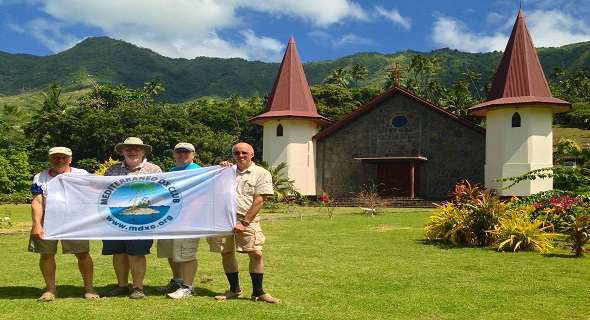“Very often when lost in admiration at its beauty, I have experienced a pang of regret that a scene so enchanting should be hidden from the world in these remote seas, and seldom meet the eyes of devoted lovers of nature.” – Herman Melville
These words were used to describe Nuku Hiva Island, the location of the TX7G DXpedition that was on the air October 19-26, 2014.
In the Spring of 2014, the idea of a Marquesas Islands DXpedition was formed. Jared (N7SMI), a relative newcomer to amateur radio with no DXpedition experience had a dream of working through the pileups on some exotic island. Through a mutual friend, Jared was introduced to Grant (KZ1W) and Marquesas was chosen as their destination. Keith (VE7KW) and Don (VE7DS), both with notable DXpedition experience, later joined as CW operators. The four-man team made over 27,000 QSOs in 8 days.
The Marquesas Islands are part of French Polynesia and are located just South of the equator 850 miles northeast of Tahiti, 2200 miles southeast of Hawaii, and 4000 miles off the South American mainland. They are one of the more remote islands in the South Pacific. At the time of the operation, Marquesas was #69 on the Club Log Most Wanted List, and #41 most wanted for Europe. There had been no large operations from Marquesas since the successful TX7M DXpedition in 2011.
After much research, the team decided to operate from Hatiheu village on the North shore of Nuku Hiva Island. Hatiheu is a very small village with ~200 residents, 5 small oceanfront rental bungalows, and one store and restaurant. This QTH was utilized by TX7M and is a good beachside location for propagation to the northern hemisphere while providing reasonable accommodations. Previous DXpeditions from the more populated and accessible southern side of the islands, or from the central valley, experienced difficulties in getting signals out. It was decided that the fly-in option of Nuku Hiva and the beachfront location and basic amenities of Hatiheu would be optimal.
As an intra-island fly-in location, careful planning was necessary to fit within the strict baggage weight and size requirements, particularly for the once-daily flight from Tahiti to Nuku Hiva. Each operator had a defined inventory and all items were weighed to the ounce. The inventory included 2 X Elecraft K3 transceivers, 1 X Icom IC-7000 transceiver (backup radio and for RTTY operations), 1 X Elecraft KPA500 amplifier, 1 X THP-550 amplifier, single-band filters for each band, 2 X SteppIR CrankIR vertical antennas, several whip antennas, and poles and wire for constructing other antennas that might be needed.
The bungalow nearest the beach was designated as the radio shack, but it was still 150 feet from the beach. Approximately 700 feet of coax, primarily low loss RG8X, was secured. A hard-packed dirt (mud after it rained) road separated the bungalow from the beach requiring the coax to be strung through the trees high above the road. The inventory was divided so that radio operations would be possible if any two operators did not arrive.
Oleg (US7UX), Alex (UT5UY), and Michel (FO5QB) from the TX7M team provided a wealth of information, and Wild Bill (WB6BFG) and Ellen (N6UWW) visited Hatiheu on vacation before our trip and provided a detailed reconnaissance report. The TX7G license and radio import authorizations were easily and quickly obtained via e-mail with the French Polynesian authorities. After months of intense planning, the team was ready to depart on the adventure of a lifetime.
The four team members, most of whom had never met the others, staged in Tahiti on October 16 and 17. After cordial visits with local amateurs Philippe (FO4BM) and Michel (FO5QB), and some final coordination, they boarded the small ATR-72 aircraft for the 3-hour flight to Nuku Hiva.
While Hatiheu village is less than 10 miles direct distance from the airport, it takes a 2-hour drive over the extreme terrain of the volcanoes that form the island to get there. Traversing hairpin turns above steep cliffs, elevation was quickly gained from the arid and brown area of the isolated airport located on the northwest shore. The scenery quickly changed to mountain forest. Towering conifer trees (something all were surprised to see there) soon covered the rugged mountains and treacherous canyons.
After reaching the summit at 3800 feet elevation, the view opened to a large central valley. While one would expect the mouth of a not-so-ancient volcano to be desolate, the green, lush mountain valley was instead lined with pine tree forests, winding streams, and cattle ranches. It seemed more a scene from the American West than a tropical island. We continued East through the valley to the more tropical regions of the island thick with coconut and palm trees, towering waterfalls, majestic volcanic spires, and breathtaking ocean bays. After miles of rough and winding road, and several stops to attempt to photograph the beauty of the scenes before us, the first views of Hatiheu were obtained.
The bungalows at Hinako Nui left much to be desired. While basically livable, insects abounded. Undetectable sand fleas would jump on our feet and ankles; their bites remained unfelt for a couple days and then itched persistently for weeks afterward. With cold-water showers and flushing toilets, the team did not complain. The amazing views of the bay and its surroundings made us quickly forget any mild discomforts.
Panorama of Hatiheu Bay looking due north. The NW and NE mountains rise to 1000’.
The nearby Chez Yvonne restaurant provided three excellent meals daily from the local catch and French fare – fish and shrimp of many varieties, massive lobsters, pork, and goat. Interestingly, chicken was not served despite there being many thousands of them roaming the island. A noisy goat next door to the shack disappeared mid-week when we placed an order for that item on the menu. We were very well fed.
We were especially surprised to find wireless internet available in the bungalows via the local post office next door. While expensive ($5/hour) and quite slow, it allowed access to e-mail, solar numbers, propagation forecasts, and, most importantly, Club Log uploads.
Antenna setup went quickly and we were soon on the air. Steve (VE2CSI), a Zone 2 station (one many would consider “good DX”) and friend to our Canadian operators, was the first to answer our CQs. Initial pileups ranged from large to massive in the first days. One station was dedicated to CW for Don (VE7DS) and Keith (VE7KW) and another to SSB for Grant (KZ1W) and Jared (N7SMI). An RTTY station was brought online mid-week. Initial propagation was good and the pileups were generally well behaved. Shifts were not pre-defined, but we soon got into a routine of approximately 4 hour shifts for the CW operators and 6 hour shifts for the SSB guys.
Antenna placement and coax routing had not been thoroughly pre-planned due to unfamiliarity with what we would encounter when we arrived. We eventually settled on 3 vertical whips directly on the sea wall (just feet from high tide) each adjustable to two bands to provide full coverage for 10-20 meters. A 30 meter vertical hanging from a fiberglass pole and CrankIR verticals tuned to 40 and 80 meters were erected slightly off the beach. Due to the baggage weight/size constraints, and to maximize QSO rate, we had determined to not operate 160 meters, nor to specialize on 6 meters.
Despite single-band contest filters, we quickly found notable station interference due to antenna proximity between 10 and 12 meters – our primary bands for mid-day operation. Keith and Grant quickly fabricated a 12 meter dipole that was hung in the trees in front of the shack. On a coax switch, no notable difference was detected in transmit or receive signals; yet the cross-polarization between the vertical and dipole removed nearly all interference between stations.
We learned other lessons, sometimes the hard way. The Marquesas Islands are in a unique time zone – UTC minus 9:30. With only a few thousand inhabitants, no modern operating system supports this time zone. We misconfigured computers and logged the first several hours of contacts with the wrong time, thus requiring log manipulation mid-operation (N1MM made this easy). Setting all systems to UTC time resolved the issues. Not establishing clear labels and instructions for coax and antenna configurations resulted in frequent confusion and downtime for band changes. We also learned that we should have separated the SSB and CW stations into separate rooms for audio isolation – the SSB operators often got a bit enthusiastic in their volume. Despite these minor difficulties, two stations were on the air nearly 24/7 for the 8 day operation, and the team members all got along very well.
On the first day of the DXpedition, the largest sunspot in 24 years rounded the horizon of the solar surface. We knew this would result in either exceptional or terrible propagation. In some ways, both were realized. At times the propagation was absolutely phenomenal. Our mid-ocean location allowed propagation to nearly the entire populated world simultaneously. It was not uncommon to work 6 continents in short succession. We worked over 1000 stations in a row on a single band several times.
Two large X-class solar flares exploded mid-week. While working 10 and 12 meters one day, we went from massive pileups to total radio blackout over the course of about 20 seconds, with US East Coast stations disappearing first, then West Coast, then finally Japan – as if someone draped a blanket over the earth. Jared on SSB and Keith on CW both looked at each other, shrugged, then went on a much-enjoyed break. No stations were heard on any band for an hour before 10 and 12 meters picked up again, often with very localized, strong propagation – much like you’d expect on 6 meters. Radio blackouts mingled with strong propagation happened a few times throughout the week.
Despite significant efforts, our numbers to Europe – 2919 QSOs (10.7%) – were not as high as we had hoped. We attribute this to the interesting propagation and radio blackouts, very strong aurora blocking the polar path, constant over-calling and intentional QRM from a few EU operators, and terrain blocking long path and low angle takeoff toward Europe. South America and Africa were also difficult as the radio horizon was greater than 12 degrees. On the contrary, with very significant terrain toward VK/ZL, we had no problem making contacts there. Due to very high local noise (S7-8) and we made fewer 80 meter QSOs there than anticipated.
In all, the TX7G team made 27,236 QSOs with 11,663 distinct call signs (42.8% unique rate). 2,300 QSOs were made in the CQ World Wide DX SSB contest in minimal operating time. There was some post-operation discussion regarding the effectiveness of the contest in providing optimal opportunity – over 800 contest QSOs were band/mode duplicates from earlier in the week. Scheduling the DXpedition to place the contest early in the operation would have certainly decreased the duplicates count. But we had fun operating the contest and definitely won FO/M (Marquesas) being the only station on the air from that entity. We made contacts to all continents (including RI1ANT in Antarctica), 133 DXCC entities, and contacted all 50 US states on 7 different bands in 150.5 hours operating time. With some slow times and notable efforts on 80 meters and RTTY (1251 QSOs) our average QSO rate was still a very respectable 181 QSOs/hour.
We especially thank the many individual donors and our sponsors: The UK DX Foundation, DX News, Elecraft, Bridgerland Amateur Radio Club, Western Washington DX Club, Oceania Amateur Radio DX Group, Mediterraneo DX Club, Clipperton DX Club, SteppIR, Utah DX Association, Tigertronics, Array Solutions, DX Italia, Mile-Hi DX Association, Nippon DX Association, KF7P Metalwerks, and Club Log.
73,
Jared (N7SMI), Grant (KZ1W), Keith (VE7KW), and Don (VE7DS)
The TX7G Marquesas Islands 2014 DXpedition Team



 3B9DJ Rodrigues
3B9DJ Rodrigues  D68Z Comoros
D68Z Comoros 

